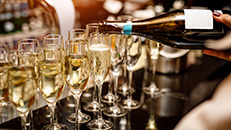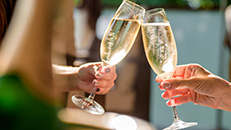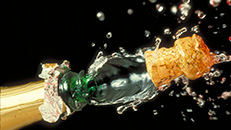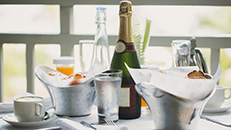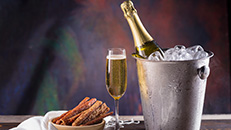Here’s what we’ll cover
Sparkling wine and Champagne are two names for the same thing–kind of. Both are wines that contain carbon dioxide bubbles, which is what gives them their sparkly nature. However, sparkling wine can be made from many different types of grapes from all over the world and there are several different styles. Champagne is a very specific type of sparkling wine—if you ask the French.
This guide will tell you everything there is to know about these popular libations, including what differentiates them, where the different varieties come from, how they’re made, how to pick some good ones, some fun drink recipes, the right way to pair a bottle with food, and even the correct way to open a bottle to get the most out of it. Cheers!
Champagne vs. Sparkling Wine
What's the difference between these two seemingly similar beverages? Well, for starters, Champagne is a specific region in France. Sparkling wine is a general term used to describe any wine with bubbles.
So, while Champagne is made from grapes grown only in Champagne, France, sparkling wines come from all over the world and multiple types of grapes.
Chances are you've probably heard of both types of wines before—who hasn't heard of prosecco? If you're feeling confused about what type of bubbly drink to try next time you are out on the town or want to celebrate a special moment, here's a guide to help you choose!
What is Champagne?
The answer to this question depends on who you ask. In the United States, people often use "Champagne" to refer to all sparkling wines made in a method similar enough to the Champagne that comes exclusively from France. France has gotten 115 other countries to respect its name-claim that "Champagne" must be a product that comes exclusively from the region of Champagne-Ardenne.
Even in France, to qualify as "Champagne," a wine must be made from grapes grown within this region and undergo secondary fermentation in bottles under pressure before being aged for at least three years in cellars where the temperature stays between 50°F (10°C) and 60°F (15°C).
The most common grape varieties used are Pinot Noir (for its light color), Pinot Meunier (for its body), and Chardonnay (for aroma).
What is Sparkling Wine?
A sparkling wine is a wine that has been bottled with a secondary fermentation that creates carbon dioxide bubbles. These wines are made in many countries worldwide. France is by far the leading exporter of sparkling wines, followed by Italy, Spain, Germany, Australia, and then the US. Sparkling wines are made from red, white, and black grapes.
Flavor Profiles
Champagne comes in a variety of styles, and the differences are determined by how much residual sugar it contains. For example, Brut Champagne has a higher level of acidity and less residual sugar than Doux (also known as Dolce) Champagne.
The driest style of Champagne is Brut, which means it has the least residual sugar (less than six g/L). These wines are very dry—so much so that some people prefer to describe them as "bone-dry" or "extra dry."
This term can also be used for other wines from around the world that have similar qualities:
- Extra Dry Sherry
This type of wine is drier than most sherry styles because it's aged for less time in oak barrels before being bottled and sold as an extra dry sherry product; this gives it more oxidative characteristics with fewer fruity notes compared to regular fino and manzanilla sherries. - Bruto (Italian)
A young Tuscan red wine made primarily from Sangiovese grapes with lower alcohol content than typical Tuscan reds. - Vin Brut Nature (French)
This term refers to sparkling wines made without any dosage after fermentation ends. - Extra Brut Natural Champagnes
These are produced either by Charmat method or in the bottle but not subjected to dosage during their first year after disgorgement; these wines must be labeled "Brut NV" instead of just NV.
Champagne Recipes
Mimosas can turn a little brunch into a wonderful afternoon and there are plenty of other ways to dress up champagne and other sparkling wines too. Here are some recipes to try with your bubbly friends.
Champagne Punch Recipe
Ingredients:
- 1 part champagne or prosecco (or sparkling wine)
- Two parts pineapple juice (fresh or canned)
- 1/2 part lemon juice (fresh or bottled)
Steps:
- Combine all ingredients in a large pitcher and stir well.
- Serve over ice.
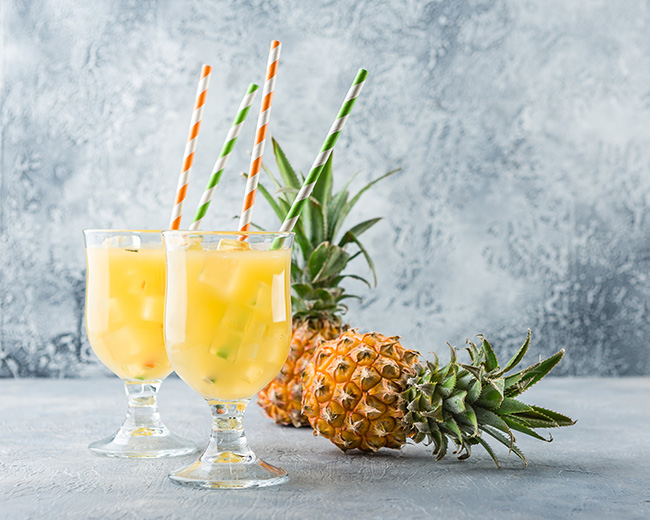
Champagne Sherbet Recipe
Ingredients:
- 1 cup champagne, chilled
- 1/4 cup simple syrup
- 1/4 cup water, plus ice cubes for blending (optional)
Steps:
- In a blender, combine champagne, simple syrup, and water until smooth.
- Add ice cubes if using them as an optional ingredient and blend until completely smooth.
- Pour into individual bowls or cups and enjoy!
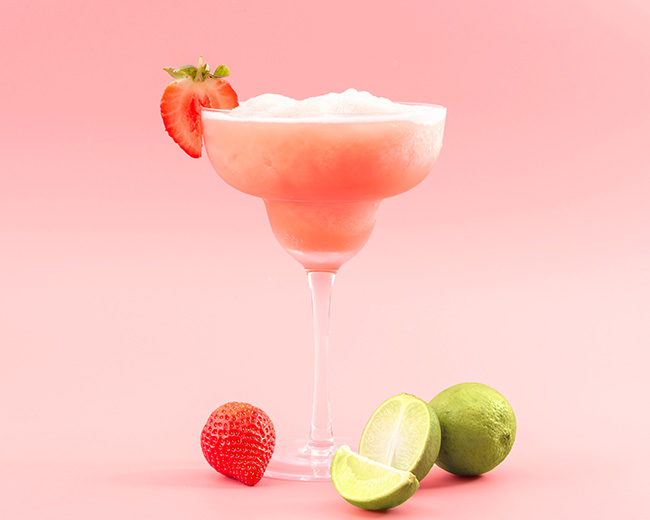
Pink Champagne Ice Cream Recipe
Ingredients:
- 1 ½ cups heavy cream
- 1 ½ cups whole milk
- 1 cup sugar
- ½ cup water
- 1 cup pink champagne (you can use any type)
- ¼ teaspoon salt
Steps:
- In a saucepan, combine the heavy cream, whole milk, and sugar. Bring to a boil over medium heat.
- Remove from heat and stir in water and champagne until dissolved.
- Stir in salt and pour into an ice cream maker.
- Allow to churn for about 30 minutes or until desired consistency is reached. Freeze until ready to serve.

Aqua de Valencia Recipe
Ingredients:
- 1 cup champagne
- 3 cups orange juice
- ½ cup Cointreau orange liqueur
- 4 tablespoons sugar
Steps:
- Add orange ingredients to a pitcher, stir, refrigerate until chilled.
- Serve over ice, garnished with a lemon or lime wedge. Salud!

Strawberry Champagne Jello Shots Recipe
Ingredients for the Strawberry Layer:
- 1/2 C water
- 2 packets gelatin
- 2 C strawberries
- 1/2 C sugar
Ingredients for Champagne Layer:
- 3 packets gelatin
- 2 C water
- 1 C sugar
- 1 1/2 C Cold Champagne
- 1 1/2 C Cold Ginger Ale
Steps for the Strawberry Layer:
- Place the water into a small bowl and sprinkle the gelatin over top to soften.
- Place the strawberries and sugar into a small pot and cook over medium heat. The strawberries will soften and release their juice and the sugar will dissolve. Add the softened gelatin to the pot and mash the strawberries with the back of a fork or a potato masher. Cook for 10 minutes.
- Transfer the strawberry mixture to a 9x13 baking dish and place into the fridge for 3 hours to harden.
Steps for Champagne Layer:
- Sprinkle the gelatin over the water to soften.
- Bring the water to a boil and stir until the gelatin is dissolved. Remove from heat. Add in sugar and stir until it's dissolved.
- Pour in the champagne and ginger ale and then top off the strawberry layer.
- Refrigerate overnight. Cut and serve.
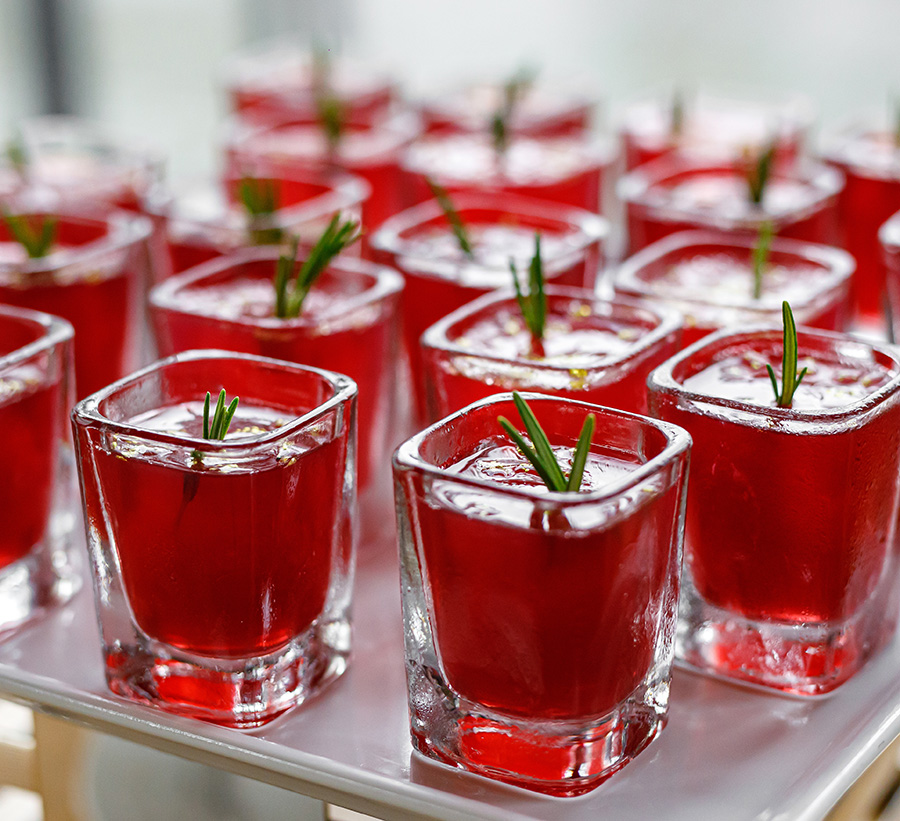
Bacio Della Luna Brut Prosecco ►
Prosecco
Prosecco is a popular sparkling Italian wine produced in the Veneto region of Italy. It's made from the Glera grape, an offspring of Pinot Noir. Prosecco has been on the rise for decades, and it's now one of the most popular sparkling wines in the world today. It's versatile enough to be drunk on its own or paired with food, and it also makes for a great cocktail ingredient! Haskell’s offers many different proseccos and they can be quite affordable.

Pere Mata Cupada
Cava ►
Cava
Cava is a sparkling wine made in the same way as champagne, but it comes from Spain. It's produced in Catalonia, which is a region north of Madrid and Barcelona.
The Cava region has about 200,000 acres of vineyards that produce grapes for more than half of all cava made worldwide. The grapes used to make cava are identical to those used for champagne: chardonnay and pinot noir for white wines; macabeo, parellada, and xarel-lo for rosé; and macabeo and parellada for sparkling red wines like crianza or reserva.
Sparkling cava undergoes an additional step called "remuage," where the lees are removed after fermentation before bottling up (this process isn't done with other types).
Haskell’s has a full selection of cavas available to suit any palate.

Villamont Cremant de Bourgogne Rose ►
Sparkling French Wine
Many other regions of France besides Champagne-Ardenne produce delicious (and sometimes less expensive) sparkling wines. In fact, there are eight other regions with their own special designations for their bounty. Some are whites and some are rosés. You can get great quality bottles of many of these for less than champagne often. The best way to learn about them is by tasting them!
- Crémant d'Alsace
- Crémant de Bordeaux
- Crémant de Bourgogne
- Crémant de Die.
- Crémant du Jura
- Crémant de Limoux
- Crémant de Loire
- Crémant de Savoie
French sparkling wines are made from the same grapes as champagne: chardonnay, pinot noir, and meunier. They're also produced using a similar method: blending still wine with a small amount of "brut" (very dry) Champagne that has been aged for at least 12 months in oak barrels.
Like Champagne, these blends are then bottled and left to ferment further in the bottle before being released for sale. This secondary fermentation gives bubbles their characteristic fizziness—you can easily see this when you pour your glass of bubbly; notice how some liquid may appear frothy on top.

Bereche Brut ►
Sparkling American Wine
American sparkling wine is made in the same way as champagne. The grapes are pressed and fermented, then undergo a secondary fermentation in the bottle with yeast added to create bubbles. Sparkling wines are typically produced via a method known as méthode champenoise.
Sparkling fruit wines are made from fresh fruit juice that has been sweetened, bottled with added yeast, and allowed to ferment in the bottle. This process creates the carbonation found in these wines.
Fortified or dessert wines have higher alcohol content than other types of wine because they've been fortified with brandy or another spirit before bottling—this gives them more flavor than regular grape juice could ever achieve alone!
Sparkling wines are a treat for all the senses if enjoyed correctly. Of course you understand the smell and taste component, and the bubbles tickle our tongues and throats in just the right way, but it’s the audible signal that can really start the experience off with a pop!
That requires opening a bottle correctly. This video from Haskell’s Chairman and CEO Jack Farrell explains the process. Remember to always make sure your bottle is well-chilled to begin with.
Sparkling wines are light but flavorful and pair well with many different types of foods. The bubbles help make finding a good match easier and the acidity of the wine helps add richness to buttery dishes.
A good place to start is by serving sparkling wine with seafood or poultry. Try a sparkling rosé with salmon tartare, or a prosecco with some grilled chicken skewers. They also go well alongside cheese plates.
Serve bubbly at brunch! Sparkling wines are perfect for a brunch or lunch party because they're light enough that they won't weigh you down after a big meal, but they still have enough flavor to make them interesting.
Cut the alcohol content and heighten the flavor by going with mimosas at brunches. If you do this, remember that adding lemon juice will make the drink sweeter overall—so be careful about adding too much!
Try pairing bubbly with desserts! People don't think of pairing champagne with desserts often—but why not try? It might turn out to be your new go-to dessert wine!
And if you don't want everything sweet all the time (and who does?), then definitely consider pairing sparkling white wines such as rieslings or chenins blancs from France instead; these can work particularly well if served alongside cheese plates or other savory hors d'oeuvres because their acidity helps cleanse one's palate between bites.
Best Champagne Brands
So now that you know what to look for, it's time to discuss the best champagne brands. To start off, we recommend Moet & Chandon Brut Imperial Champagne, Dom Pérignon Vintage Brut Champagne, and Veuve Cliquot Yellow Label Brut Champagne.
Krug Grand Cuvee is worth every penny if you're looking for something a little more expensive and rare. The same is true for Bollinger Special Cuvée. These are both treats that are worth indulging on if your budget allows. Another great one from the top tier is Taittinger Comtes de Champagne Methode Traditionelle Sparkling Wine.
A less expensive but still very high quality option is the Lanson Black Label Brut. An even more economical alternative is Korbel Extra Dry Sparkling Wine.
Best Sparkling Wine Brands
If you want to know what brands are worth your money, here are our sparkling wine recommendations.
Domaine Chandon Brut Classic ►
Domaine Chandon Brut Classic
The wine blends chardonnay, pinot noir, and pinot Meunier grapes. It has a nose of apples and pears with a hint of cinnamon and vanilla. The taste is dry with peach flavors and a crisp finish.

Gruet Brut Methode Champenoise ►
Gruet Brut Methode Champenoise
This wine is made from chardonnay grapes grown on California's Central Coast. It has notes of lemon, pear, and green apple with a creamy texture and slight effervescence. It pairs well with seafood dishes and mild cheeses.

Mumm Napa Valley Brut Prestige ►
Mumm Napa Valley Brut Prestige
This sparkling wine comes from the Napa Valley region in California, where it was made with chardonnay grapes grown in limestone soil. It has aromas of crushed flowers and citrus fruits with flavors of white peach and apricot on the palate, along with notes of honeydew melon that linger on the finish.
Conclusion
So, what should you buy if you're in the market for a bottle of bubbly or sparkling wine? We've outlined some great brands in both categories above. When choosing for yourself, don't be afraid to experiment! With so many options out there today (and even more on the horizon), you’re sure to find something that perfectly fits your tastes.

